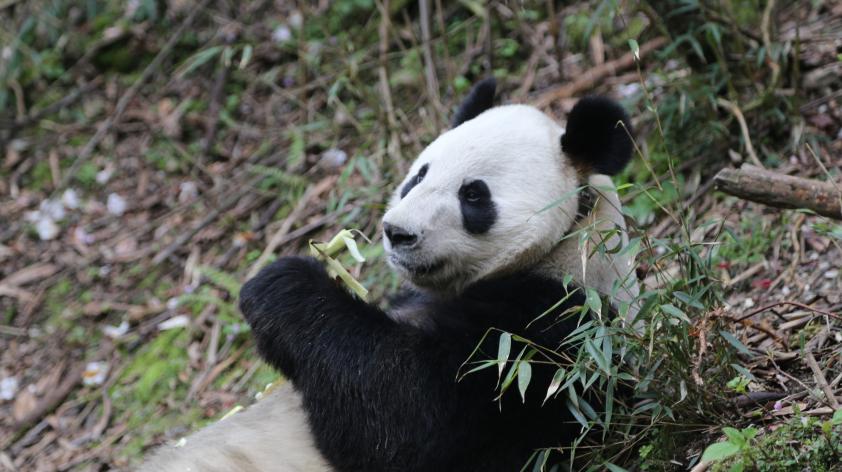
Rewilding giant pandas
I breathe in the cool mountain air and peer through the bamboo stands straining to see a moving black and white form, a shadowy outline moving through the dense vegetation. I strain my neck, scanning back and forth and…there it is! I get a good glimpse of the giant panda…in the wild? No, this one is in a very large enclosure and is being prepared for a new life in the wild soon. But I know well the excitement of “panda watching” wild pandas too. It’s all waiting, hoping, expecting, and the rewards are usually little more than a fleeting glimpse or an obscured view through thick bamboo forest. Unless of course they are in the mating mode and then they are noisy and distracted and easy to watch.
I am here with San Diego Zoo Global scientist, Dr. Megan Owen, at the Tian Tai Shan reintroduction center just outside of the Wolong Nature Reserve where the China Center for Research and Conservation of the Giant Panda (CCTCGP) is training pandas born at their breeding centers for life in the wild. The idea is to bring a mother with a very young cub to these large, naturalistic enclosures that are not too disparate from what pandas would experience in their wild habitat. The cub will be released, not the mother, and it will have no experience with the artificial environments back at the breeding centers. And, we at San Diego Zoo Global are working closely with the Center to develop this training program, an exciting prospect. Wu Daifu, who is heading up this effort, is showing us around. The creative juices are flowing.
As part of her postdoctoral fellowship with us, Dr. Meghan Martin will be doing a series of studies designed to learn what pandas need to know for life in the wild, and how we can promote some of those essential behaviors. We have brainstormed a number of ideas. One is to look at bamboo feeding. On the surface, it might seem quite simple. Reach, grab, bite, chew, swallow. But it is more subtle and complex than that. Which bamboo? Which ones are most nutritious. We must look at how they select what to eat. Also, for an animal that spends 14 hours a day eating just to get enough nutrition, a panda must be an efficient eater. Watching a panda eat, they are almost elegant in their movements, quickly stripping the stems of their hard outer layers or making a big wad of leaves before eating. These behaviors help them maximize intake of nutritious food. We will therefore study and promote feeding efficiency. After all, a panda can’t eat 24 hours a day.
But pandas must do much more than just eat to survive and thrive in the wild. They must also know how to avoid becoming prey. Although adults are probably nearly immune to predators, the youngsters can fall prey to leopards, black bears or feral dogs if they are not wary. Indeed young pandas spend a great deal of time up trees, almost certainly to avoid predators. So we will be looking at their antipredator behavior, their use of trees, and other important factors that can help them elude predators.
Another threat—and opportunity—is other pandas. A released panda must know how to integrate into the social network. Although predominantly solitary, pandas are not asocial, and they must learn how to communicate with one another, when to approach and when to avoid, how to court and mate, and, especially for males, how to compete with one another. Male-male competition can be dangerous and deadly. So we will also be measuring these pandas’ social competence and developing ways to encourage it. Panda cotillion.
Back at the reintroduction enclosures at Tian Tai Shan, my mind races with these opportunities as I watch a mother and cub move in and out of view. The mother, reared more traditionally in a breeding center, is more used to humans, and even comes down to have her GPS collar battery exchanged (for which she is given a treat). She will not be released, though her cub will in another year. As planned, the cub keeps its distance and is nowhere to be seen. It will be less aware of humans, and people will remain a neutral stimulus. We don’t want released pandas to be attracted to humans.
As the female panda slowly melts back into the forest, I think how lucky I am to be here and to have this opportunity. In many ways, this project is the perfect fit. My experiences intersect perfectly to prepare me for this role: two decades of study of pandas in breeding centers, nearly as long working with wild pandas, and a career developing reintroduction techniques for a range of other species.
In addition to the intellectual fit, for me this is deeply personal. Since we have helped get the pandas breeding and producing cubs, I care what happens to them next. I want to make sure they make meaningful contributions to the species’ conservation (they will by supplementing small, isolated wild populations that are at risk of inbreeding depression), and that they do not needlessly suffer too rough a transition to the wild. Although pandas have reached a major milestone recently and were downlisted from Endangered to Vulnerable, it is time now for us to role up our sleeves and get on with the continued work necessary to keep them on the path to recovery.
Experiencing these soon-to-be-wild pandas at Tian Tai Shan has been a real treat. But I do hope that one day I will catch a fleeting glimpse of a wild panda that got its start at the breeding center.













